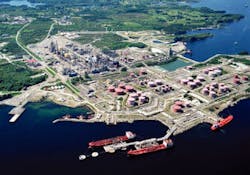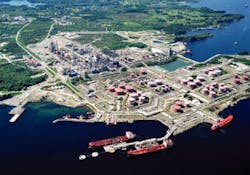DONG Energy, Hydro ASA, and Royal Dutch Shell PLC agreed to cooperate with Statoil ASA in planning a carbon capture and storage (CCS) test center at a combined heat and power station (CHP) being constructed at Statoil’s 200,000 b/cd Mongstad refinery. Electric power company Vattenfall AB of Sweden also signed the CCS agreement.
The CCS test center, which will have an initial capacity of capturing 100,000 tonnes/year of carbon dioxide, is to be in place when the CHP plant starts operating in 2010. The center will be run by a technology company consisting of a partnership of Statoil, the Norwegian government, and the newly announced partners. Statoil will own 20% of the center, to be called the European CO2 Test Centre Mongstad.
A 2006 agreement between the Norwegian government and Statoil outlines plans to develop an “environment-friendly” power project at Mongstad. The CHP station is expected to supply 280 Mw of electricity and 250 Mw of heat. The refinery will use some of the heat and electricity with the surplus electricity probably to be sold to Norwegian oil and gas operations, including Norwegian North Sea platforms.
The Norwegian Ministry of the Environment issued an emissions permit stipulating that a full-scale CCS project must proceed in parallel development with the CHP station. The full-scale CCS project, scheduled to be in place by Dec. 31, 2014, involves only the Statoil and the government, at least at this point.
The center will be capable of testing more than one type of CO2 capture technology. Planners will spend the next several months selecting a detailed concept for additional preengineering and executing front-end engineering design contracts. Project sanction is expected in first quarter 2008. The Norwegian Ministry of Petroleum and Energy would like the planning partners to participate in the test center after project sanction, although they have yet to make that commitment, a ministry spokesman said.
Statoil’s carbon strategy
Statoil said the test center will develop, test, and qualify carbon capture technology to help reduce costs and risks associated with large-scale carbon capture. The company’s intention is to develop technology capable of capturing more than 2 million tonnes/year of CO2 at Mongstad. Both Statoil and the Norwegian government intend for technology and expertise acquired there to be available for international application.
In a related development, Statoil signed a joint development contract with technology development company Alstom to test chilled ammonia capture of CO2 from flue gases particular to natural gas combined-cycle power plants. The objective is to construct a chilled ammonia test plant, and Statoil intends to include this in the work at the Mongstad test center.
Statoil and Alstom have collaborated on chilled ammonia capture since 2005, and the joint development contract is a step toward commercialization, Statoil said. Research indicates chilled ammonia-based CO2 capture can remove as much as 90% of CO2 from flue gases, Alstom said.
“We have chosen to work in parallel with one technology with great potential, chilled ammonia, which is less mature and therefore represents a higher risk,” said Dag Vareide, Statoil’s vice-president for research and technology. In parallel, Statoil plans to advance CO2-removal amine technology.
“We have more experience with amine technology, and its use includes carbon capture at Sleipner, Snohvit, and In Salah,” Vareide said.
At Sleipner natural gas field in the Norwegian North Sea, CO2 content is about 10%. The CO2 has been extracted from the gas flow since 1996 at the rate of 1 million tpy and reinjected into a nonpetroleum reservoir at 1,200 m overlying the field reservoir, which lies at 3,000 m subsea. The aim is to gather data to develop sound methodologies for assessment, planning, and long-term monitoring of underground CO2 storage on and offshore.
Snøhvit gas field in the Norwegian Barents Sea has a high CO2 content. The development includes piping the field gas to an onshore facility. CO2 will be extracted from the gas stream and piped back offshore for injection into a sand aquifer underneath the gas field. The methane will be converted to LNG at the onshore facilities.
In Algeria, Statoil in involved with CO2 sequestration at the In Salah project, which involves a group of gas fields and a massive processing complex. BP PLC is the project operator.

